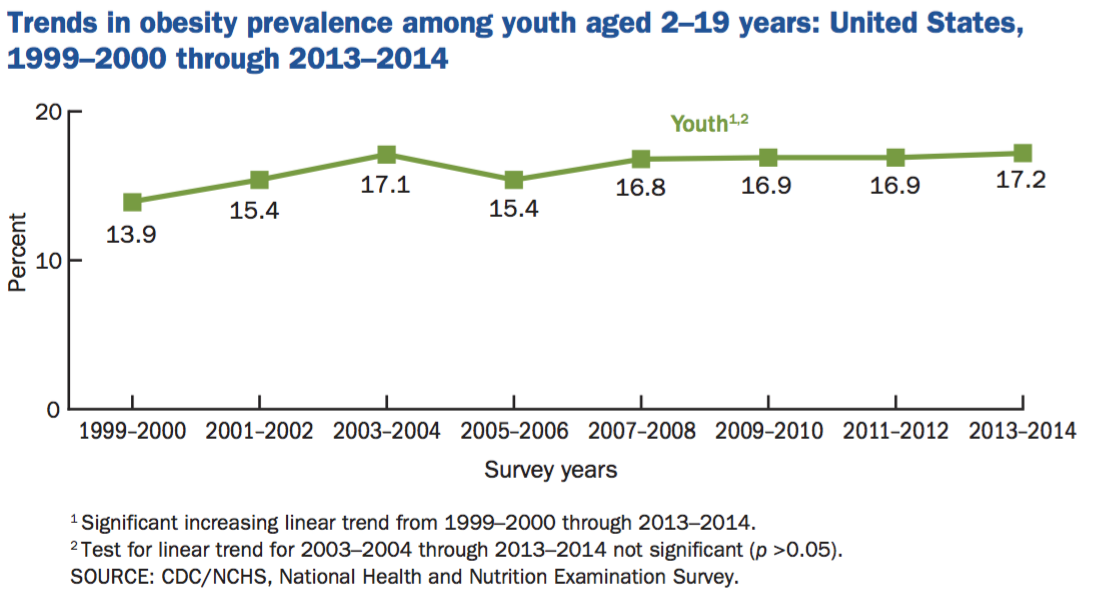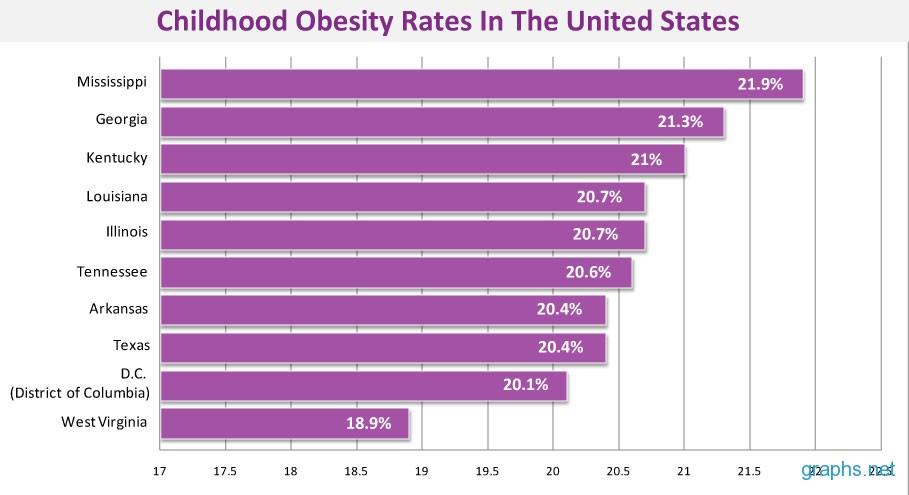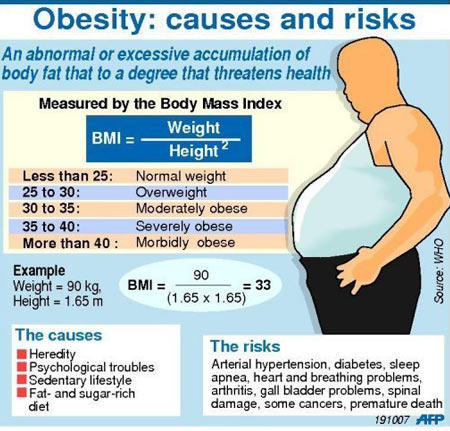Introduction
Childhood obesity is one of the current epidemiology issues that society is trying to deal with in my state. Dipti, Brent, Fiese, Jones, and Hyunkeun (2013) define obesity as “a condition where a person has accumulated so much body fat that it might hurt their health” (p. 404). It is important to understand the difference between obesity and overweight. Although the two are closely related, there is a difference in terms of the weight of a person. Anyone who has a body mass index (BMI) of 25 to 30 is considered overweight. If a person’s BMI is more than 30, then he or she is considered obese. This health problem is becoming common because of the changing lifestyle in society. Junk food has become common and very popular not only in this state but in many other parts of the United States.
With the emergence of computer games, children are spending more time indoors than was the case in the recent past. When they come from school, they rush home to play using their computers or other indoor games. Physical activities among this group of people have become less and eating habits have worsened. According to Zahnda et al. (2015), obesity is associated with several health problems such as high blood pressure, atherosclerosis, asthma, and diabetes among other health problems. When a child is faced with such numerous health risks, it becomes a major concern not only to the parents but also to the state in terms of budgetary allocations. In this paper, the researcher is focused on conducting a study on childhood obesity in the village of Lincolnwood, Cook County, in the state of Illinois.
Background of Childhood Obesity
Childhood obesity has gained the attention of medical practitioners, teachers, parents, and many other stakeholders for several reasons. One of the main causes of concern about childhood obesity is the health problems that it exposes a child to at such a tender age. Healthcare practitioners are keen on ensuring that children do not become vulnerable to these diseases by trying to fight obesity through public awareness campaigns and other strategies. For teachers and parents, health factors may be a concern, but they are also concerned with the self-esteem of their children. According to Chriqui, Chaloupka, Powell, and Eidson (2013), children who are obese are not as active as their peers with normal body weight. It means that sometimes they are unable to join them in playing various games or other academic activities that are physically demanding. This condition may affect their self-esteem. Sometimes they might be affected by constant bullying by their colleagues who consider their weight to be abnormal. It is worrying that at the national level, statistics show that childhood obesity is on the upward trend as shown below.

As shown in the above statistics, there is a consistent rise in childhood obesity in the United States since 1999. There was a slight drop in the population of obese children from the year 2003 to 2006, but these gains were lost from 2006 to 2014. Technology that is eliminating physical games and poor eating habits have been blamed for the increasing rates of obesity. In the state of Illinois, this problem has been a concern, and stakeholders are trying to find ways of dealing with it. In Lincolnwood village, the problem is not as pronounced as it is at the national level (Zahnda et al., 2015). However, it is still a concern among parents, teachers, and medical practitioners keen on ensuring that children remain active and healthy as a way of reducing their vulnerability to the lifestyle diseases associated with obesity.
Current Surveillance Methods
Fighting childhood obesity requires having clear data that shows trends and patterns to come up with an approach of dealing with it. Coming up with effective epidemiology surveillance is, therefore, very critical. In Cook County, Chriqui et al. (2013) say that the government has an “ongoing systematic collection, recording, analysis, interpretation, and dissemination of data reflecting the current health status of a community or population” (410). Childhood obesity is one of the medical issues which are under close surveillance by the government. Cook County’s Department of Health has initiated various programs that are meant to assess the state of obesity among children within the county. The department works closely with hospitals and schools within the region to help determine the current status of this health condition and the trend it has been taking over the recent past.
One of the areas of interest that the department of health has been concerned with is the factors contributing to the prevalence of the condition and the risk factors associated with it. The decision to involve schools was because not all cases of obesity end up in hospitals hence the scope of the surveillance had to be widened. The department also wanted to collect data about the physical activity of students, especially those who were considered obese. Such data would help in determining the relationship of physical activity among these children and the prevalence of obesity. When collecting this data, the team is often keen to compare national and local data to determine the progress that is being made in fighting obesity at the county level. In the table below, there is a comparison of obesity and overweight cases among children in Cook County and that of the United States.

As shown in the data above, obesity is a serious issue among 6th graders who are aged about 10 to 12 years. The data above also show that obesity is a serious issue in Cook County when it is compared to the national average. It is an indication that more needs to be done to combat this problem at the local level. The Department of Health of Cook County has been working closely with the Center for Disease Control and Prevention (CDC) in its epidemiological surveillance as a way of enhancing the accuracy in its data and gathering information about what is happening in other counties.
As Nehra, Allen, Mailing, Kashyap, and Woods (2016) note, obesity is a lifestyle disease and it is almost impossible for the county government to force a specific lifestyle upon its people. It will be considered infringing on their rights and freedoms. However, such comparative statistics are important because they may help the county government to understand what other counties are doing right to lower their rates of obesity incidences. As Maddock (2012) says, coming up with an effective strategy for combating diseases such as obesity is critical because the government is focused on lowering healthcare expenses.
Epidemiological Analysis of Childhood Obesity
According to Zahnda et al. (2015), the United States has one of the highest incidences of childhood obesity in the world. Studies conducted by the Center for Disease Control and Prevention revealed that about 25% of children below five years, and 31% of school-going children in the country suffer from obesity or are overweight (Chriqui et al., 2013). The studies also revealed that African Americans and Hispanics are the most affected population in the country. It was also evident that Mississippi is the worst affected state when it comes to childhood obesity. The figure below shows how the states are ranked based on the reported cases of obesity in the country.

The states of Mississippi, Georgia, Kentucky, Louisiana, and Illinois are among the top five most obese states in the country. The statistics are very worrying for the Department of Health in Illinois, having been ranked one of those with the highest cases of childhood obesity in the country. Maddock (2012) says that having about 20.7% of children being obese means that the state may need to prepare to spend more in the healthcare sector. It is important to note that those who are overweight are not included in this calculation. If they were to be included, then it is likely that about 40% of children in this state are either obese or overweight.
Studies have indicated that other than dieting and physical activities of children, there is also the problem of inheriting this condition from parents. According to Chriqui et al. (2013), if either of the parents is obese, then chances are 50% that the child will be obese. This percentage becomes even higher if both parents are obese because the chances of acquiring the genes are higher. According to Nehra et al. (2016), obese parents often engage in limited physical activities such as exercise hence are unable to inculcate the culture into their children. These children also grow up knowing that being fat is normal because they see it in their parents. Some parents feel that they lack the moral authority to tell their children to work on their weight if they are having the same problem. In Lincolnwood Village, the problem of childhood obesity is not as high as it is at the state level, but it is still a concern that stakeholders are trying to find the best way of dealing with it.
Screening and Diagnosis of Childhood Obesity
The diagnosis of obesity among children is not a common trend in the United States. According to Kwon, Mason, and Welch (2015), many people do not even realize that they are overweight as long as they can move with ease and do not have a health condition that may draw attention to their weight. A study by the Center for Disease Control and Prevention shows that regular screening is important for anyone who wants to maintain normal body weight. The most commonly used method of determining the normality of one’s body weight is through measuring their body mass index (BMI). This is a simple process that involves determining one’s weight and height. Body mass index is determined by dividing their weight by a square of their height in meters. The figure below shows how BMI is calculated, and how the outcome is classified as normal, overweight, moderately obese, severely obese, and morbidly obese. The figure also shows the risk factors and risks associated with overweight and obesity.

As shown in the above classification, anyone with a BMI of 25 to 30 is considered overweight. However, Maddock (2012) says that many people often fail to consider children with such body mass index as overweight. Those who have a BMI of 30 to 35 are classified as moderately obese. They may not have problems with movement, but they will find it difficult to engage in physical activities for a long time. Those with a BMI of 35-40 are classified as severely obese. Physical exercise and even normal movement come with a lot of strain. Such children would prefer spending most of their time seated because of the discomfort that is associated with physical activities. The last group is those with a BMI of more than 40. They are classified as morbidly obese. They can barely walk and moving any part of the body is serious stress to them. This is a very dangerous stage because they are susceptible to many lifestyle diseases like diabetes and coronary diseases such as high blood pressure. Children who are morbidly obese lack self-esteem and this does not just affect their health but also their academic performance and social development.
Plan of Action
It is clear from the analysis above that childhood obesity is a serious problem that the community in Lincolnwood village will have to deal with to counter its negative consequences. While the government is looking at strategies that it can use to deal with the problem, practitioners should also work on ways of handling this problem. As a practitioner, I have a plan on how I, closely collaborating with other stakeholders, intend to deal with childhood obesity in Lincolnwood village in Cook County. One approach I intend to use is the creation of awareness about obesity and its consequences among schools within this village. According to Zahnda et al. (2015), one of the biggest setbacks in the fight against obesity is lack of awareness. I intend to sensitive students and teachers about the issue of obesity and how children can remain physically active when they are in school.
According to Chriqui et al. (2013), parents play a significant role in defining how active their children are when they are at home. They are the ones who purchase computer games that make children spend most of their time indoors. As such, I will work with other colleagues to try and reach these parents in churches, at work, or in any social gatherings to remind them of their role in the fight against obesity. According to Nehra et al. (2016), one of the best ways of dealing with obesity is to remain physically active. I intend to work closely with schools’ administrations to promote various forms of sports among children. This will allow them to be physically active most of the time they are in school.
Conclusion
Obesity is associated with numerous diseases, and, unfortunately, Illinois is one of the states with the leading causes of childhood obesity in the United States. In Lincolnwood village in Cook County, obesity is an issue that demands immediate attention. To protect children from dangerous diseases such as diabetes and heart problems known to claim many lives in the country, the stakeholders must work together to address this problem. They must ensure that children remain active when at home or in school. They must also maintain a healthy diet at all times.
References
Chriqui, J., Chaloupka, F., Powell, L. & Eidson, S. (2013). A typology of beverage taxation: Multiple approaches for obesity prevention and obesity prevention-related revenue generation. Journal of Public Health Policy, 34(403), 403-423. Web.
Dipti, A., Brent, A., Fiese, B., Jones, B. & Hyunkeun, C. (2013). Risk Factors for Overweight/Obesity in Preschool Children: An Ecological Approach, 9(5): 399-408. Web.
Kwon, S., Mason, M. & Welch, S. (2015). Physical Activity of Fifth to Sixth Graders During School Hours According to School Race/Ethnicity: Suburban Cook County, Illinois. Journal of School Health, 85(6), 382-387. Web.
Maddock, J. (2012). Addressing Physical Activity, Obesity, and Wellness in Schools. American Journal of Preventive Medicine, 43(3), 351–352. Web.
Nehra, V., Allen, J., Mailing, J., Kashyap, P. & Woods, A. (2016). Gut Microbiota: Modulation of Host Physiology in Obesity. Int. Union Physiol. Sci. 31(5), 327-35. Web.
Zahnda, W., Rogersb, V., Smithc, S., Ryherda, S., Botchwaya, A. & Stewardd, D. (2015). Gender-specific relationships between socioeconomic disadvantage and obesity in elementary school students. Preventive Medicine 81(1), 138–141. Web.